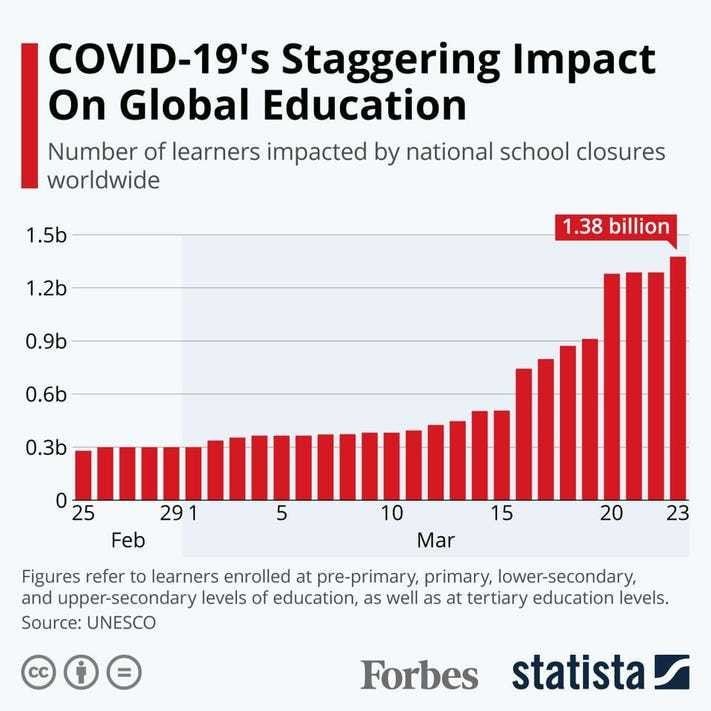What are the long-term effects of the COVID-19 pandemic? These 5 trends give us a glimpse
00:0009:31
- The COVID-19 pandemic has brought unprecedented digital acceleration, changing the face of the economy and society.
- Cognizant has asked internal and external thought leaders to share their vision of this fundamental digital transformation.
- The future of work, our social lives, education and security will all undergo major change in the aftermath of the pandemic.
The COVID-19 pandemic has had a profound impact on our world and cost millions their lives. It’s disrupted economies and education systems and taken away livelihoods.
Governments, businesses and individuals have been forced to adapt rapidly, in many cases leaning on an existing digital transformation that was already underway. For millions of office-based workers, the technological workarounds adopted during the pandemic have potentially changed working lives for ever.
To sketch out a vision of the future that reflects this profound digital transformation, technology consultancy Cognizant brought together a group of its internal and independent thought leaders.
Here are five developments these experts predict we’ll see in the not so distant future as long-term impacts of the pandemic on society and the economy.
Have you read?
1. The future of work (and life) for office workers
The pivot from office-based work to working from home (WFH) will have long-lasting effects on business and society - particularly for those who used to work in offices. Ben Pring, co-founder and head of Cognizant’s Center for the Future of Work, envisions the office of the future as a space that serves three main functions: a showroom for clients, a research-and-development lab and a ‘party space’ for WHF staff to get together with work colleagues. In some cases, these functions will be found in the same building, but for many companies, different spaces will serve different purposes: some owned and some - like a space for regular staff socials - rented as needed.

2. The advent of ‘15 minute spaces’
With office and home merging together - and without the commute, the water cooler and the canteen - we need ‘new’ spaces to help break up the working day. One strategy for the future of work is creating neighbourhood hubs that workers can easily get to from their homes within 15 minutes, including amenities such as restaurants, bars, a gym or an art gallery, to name a few. The expectation is that these spaces will not only provide a reprieve from work but also enable workers to build new social networks away from the office.
Cognizant’s report highlights US start-up Reef, which aims to create cities where everything people need is within a short walk or bike ride. Similarly, Saudi Arabia is building a 100-mile stretch of smart communities connected without cars, all held together by digital technologies.
3. Delivery from your ‘cloud market’
The popularity of restaurant food deliveries skyrocketed during the lockdown, calling into question what would happen to restaurants once they could open up again.
While traditional sit-down-and-eat restaurants may face more of a challenge, others may be able to bank on the ongoing trend towards ‘experiential dining’ - eating out in unique locations, new concept kitchens or even taking in a performance during the meal.
Alongside, building on the success of restaurant food deliveries, we will soon see the rise of pop-up kitchens with no front of house or seating that rely on delivery services alone. Clayton Griffith from Cognizant Softvision predicts that these ‘ghost kitchens’ will develop into ‘cloud markets’ allowing you to mix and match dishes from a wide variety of sources and have them delivered to your home.

4. Security in a heartbeat
Digital acceleration has also put the limelight back onto security issues. Much of the world’s move to online - whether for work or your weekly shop - involves sharing personal or business information remotely, with an ever-wider number of entities. Not only that but when people started wearing masks, facial recognition security systems were stumped.
One solution to this conundrum may be the unique pattern of your heartbeat. Developed by the Pentagon and NASA, ‘cardio ID’ devices can detect an individual’s unique cardiac signature using an infrared laser. The technology is already available for licensing, and security is only one possible use. Another application could be identifying opted-in shoppers as they enter a store, for example, to personalize their visit.
5. Digitally accelerating and adapting how children learn
Homeschooling during the lockdown may have been a stressful experience for parents and pupils - especially for families with limited connectivity and access to digital devices. More than 1.3 billion children were shut out of their schools during the pandemic, as the chart below illustrates.

As well as the challenges faced by some families, there were also advantages: more family time, improving children’s digital skills, allowing them to learn at their own pace and engaging them in real-life problems - including their parents’ world of work.
Cognizant’s gaze into the future sees these advantages being carried across into a hybrid learning environment, where pupils’ time is split equally between school and home learning.
The idea behind this is combining the best of both worlds - school and home - to help children become more independent and creative as well as develop their emotional intelligence.
The long-term impacts of the pandemic on the economy and society will be many and varied, and there are other social and economic transitions looming.
It is also important to acknowledge that many of the trends spurred by the digital acceleration are anchored in the developed world, and may not apply to developing economies in the same way.
The World Economic Forum’s report Accelerating Digital Inclusion in the New Normal has pointed out important gaps in infrastructure, connectivity, access and affordability to technologies in emerging markets.
Making our world more resilient and ‘building back better’ means addressing these challenges to digital transformation comprehensively, for the whole world.






沒有留言:
張貼留言